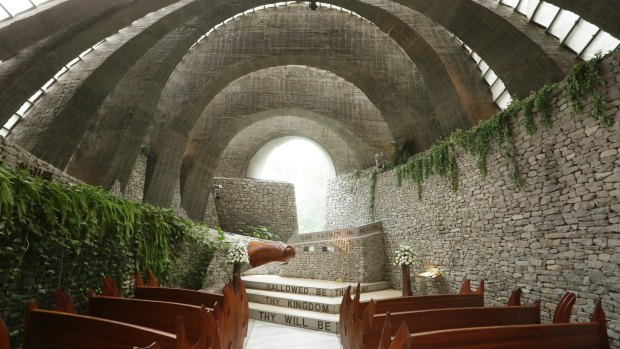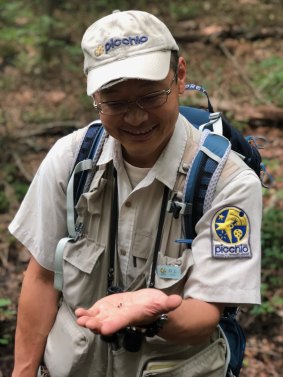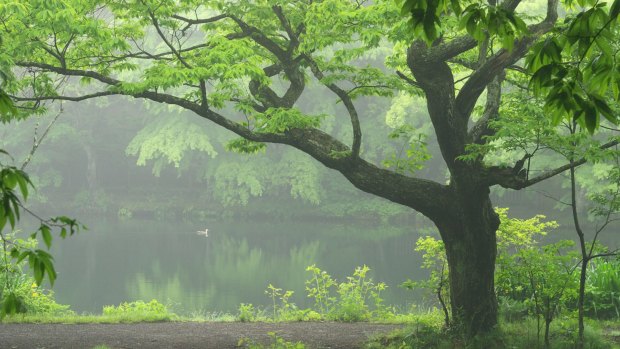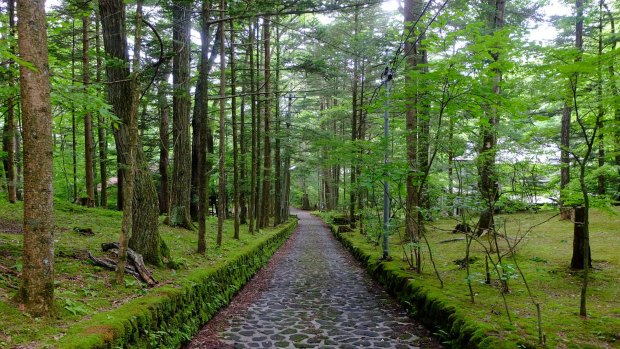This was published 5 years ago
Karuizawa, Japan: The resort town where the rich and royal go for summer holidays

Stone church at Karuizawa, Japan.Credit: Shutterstock
Even the dogs are fabulous in Karuizawa. Walking through this upmarket Japanese mountain town, an hour's train ride northwest of Tokyo in Nagano Prefecture, I pass two perfectly groomed schnauzers in a cafe – one in a tutu, the other in a star-print blue jumper. Around the corner, a couple push a pair of white poodles, with afros to beat Jimi Hendrix's, in a pram.
These coiffed canines should come as no surprise. Since Karuizawa was developed 140 years ago, it has been the summer getaway of choice for the rich and the royal of Japan. The types of people who buy prams and booties for their dogs. The current emperor of Japan famously met his wife playing tennis here in 1958, the imperial family still visits most summers, and in the 1970s, John Lennon and Yoko Ono spent months here too.
Visitors come to this leafy resort town, set 1000 metres above sea level, to escape the hot, muggy Tokyo summers. They come to in winter too, to ski and to soak in the town's hot springs. Year-round, they come to see and be seen.

Our guide tells us that this forest is home to creatures including Asian black bears, a Japanese goat-antelope called a serow and the musasabi, the world's largest flying squirrel.Credit: Nina Karnikowski
Our Karuizawa wanderings begin in Harunire Terrace, a line of upscale wood-built stores and restaurants set in the forest. It's the most elegant shopping area, the kind of place where organic cotton pyjama sets worth $500 sit alongside $75 hand-carved wooden bowls and plates in chic boutiques. I can't afford anything. But I do make the most of spying on the flawless local shoppers, who all seem to be wearing the same oversized, layered linen outfits.
Karuizawa is well-known for its experimental minimalist architecture, with many of the alpine town's houses and buildings designed by prominent Japanese architects. Nearby is one of the most famous, the Hoshino Wedding Chapel, built with cascading concrete arches inlaid with stone and glass, and without a single right angle. We don't have time for a visit. But luckily, examples of this avant-garde architecture are all around.
The restaurant we eat our tasty trout sashimi rice bowls in, Sonmin-Shokudo, is set in a leaf-shaped glass and steel space, that sits in a cleared patch of forest like an abandoned spaceship. And when we arrive for our guided forest walk at eco-tour company Picchio, I quickly decide that theirs is the world's most tasteful visitor centre. Built in a sweeping arc that hugs the side of a pond, the glass front of the building opens onto the water, which transforms into an ice rink in winter. It's a building that doesn't disrupt or engulf its surroundings, but instead feels a seamless part of it. I could stay and admire the shingle-clad structure all day. But I have a hike to attend.

Karuizawa forest.
The Japanese have been practising something called shinrin-yoku, or forest bathing, since 1982, when the Japanese Ministry of Agriculture, Forestry and Fisheries suggested it as a healthy lifestyle practice. I've always considered it a rather odd concept. As we start walking through the forest, though, I start to get it.
Surrounded by a thick press of fir and larch trees, iridescent dragonflies flitting by and birdsong all around, I feel my pulse rate slow and my body relax. Karuizawa is a town of 20,000 inhabitants, but here in the forest I feel alone.
Which I'm not, apparently. Our guide tells us that this forest is home to creatures including Asian black bears, a Japanese goat-antelope called a serow and the musasabi, the world's largest flying squirrel.

Cobbled pathway often known as "Happy Valley", Karuizawa, Nagano, Japan.Credit: Shutterstock
We don't encounter any of them today. But on our way out of the forest, we do meet what just might be Karuizawa's most fabulous resident of all. A pug, wearing tiny orange booties and a T-shirt that reads "pug life."
TRIP NOTES
Nina Karnikowski travelled as a guest of the Japan National Tourism Organisation.
MORE
FLY
Qantas flies from Sydney and Melbourne to Tokyo, which is an hour by the Nagano shinkansen bullet train from Karuizawa. See www.qantas.com
Sign up for the Traveller Deals newsletter
Get exclusive travel deals delivered straight to your inbox. Sign up now.